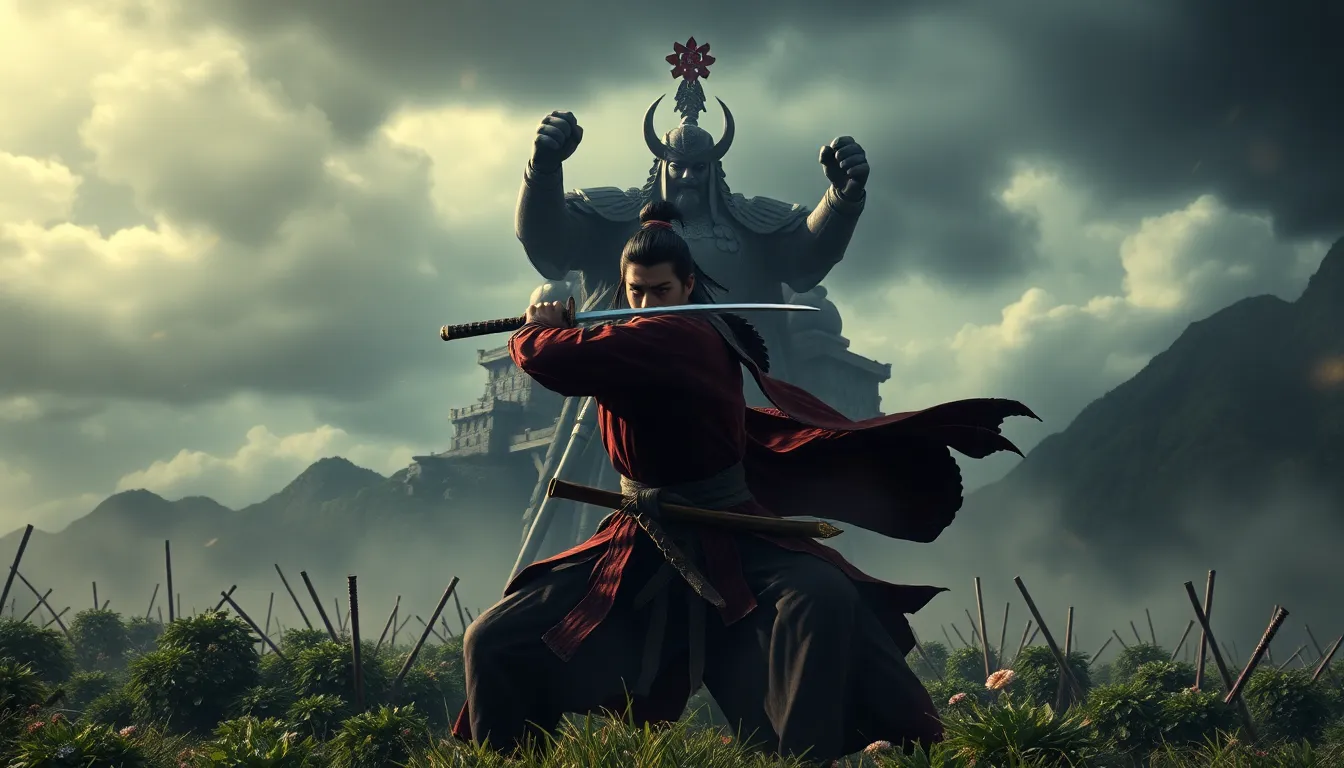In the breathtaking world of Ghost of Tsushima, players don’t just fight for survival; they embark on an epic journey filled with rich narrative arcs that rival the most gripping novels. Set against the backdrop of feudal Japan, this game weaves a tale of honor, betrayal, and the struggle between tradition and innovation. If you thought your family drama was intense, wait until you dive into the emotional rollercoaster that is Jin Sakai’s quest.
From the heart-wrenching choices that shape the protagonist’s path to the colorful cast of characters who either uplift or undermine him, each narrative thread is meticulously crafted. Whether it’s battling Mongol invaders or wrestling with his own identity, Jin’s story resonates deeply, proving that even a samurai can have a mid-life crisis. So grab your katana and prepare to explore the intricate layers of storytelling that make Ghost of Tsushima a must-play masterpiece.
Table of Contents
ToggleOverview of Ghost of Tsushima
Ghost of Tsushima immerses players in feudal Japan during the Mongol invasion of 1274. Players engage with themes of honor and betrayal while following Jin Sakai’s emotional journey. The storyline emphasizes the struggle between tradition and the necessity for change.
Jin’s initial dedication to samurai values shifts as he faces daunting challenges. Characters such as Lady Masako and Norio significantly impact his path. Emotional connections with characters foster deeper player engagement.
Many narrative arcs develop alongside the main storyline, enriching the overall experience. Players navigate pivotal decisions that shape Jin’s destiny and influence relationships. Character development remains a key strength, showcasing the evolving dynamics as Jin transforms throughout the game.
The game’s visual design complements its narrative, enhancing the storytelling. Stunning landscapes and detailed environments reflect historical accuracy and cultural elements. Music and voice acting deepen the immersion, making the player experience more profound.
Players discover various side stories that reveal the complexities of feudal Japan’s society. Themes of loyalty, loss, and resilience resonate throughout these arcs. Notable side characters provide unique perspectives that highlight different facets of the struggle against the Mongol threat.
Overall, the narrative arcs in Ghost of Tsushima blend seamlessly with gameplay mechanics. Each choice impacts the unfolding story, ensuring an adaptive and engaging playthrough. As Jin Sakai rises to meet his destiny, players witness a rich tapestry of emotions and relationships that make the journey unforgettable.
Main Narrative Arcs

Ghost of Tsushima features several compelling narrative arcs that enrich the gameplay experience. These arcs intertwine with themes of honor, betrayal, and personal growth, providing players with a deep narrative journey.
Jin Sakai’s Journey
Jin Sakai undergoes significant transformation throughout the game. Initially committed to traditional samurai values, he faces insurmountable challenges that force him to reevaluate his beliefs. The struggle against the Mongols introduces him to new tactics, often at odds with his upbringing. Encounters with key characters such as Lady Masako and Norio influence his development. Each decision Jin makes impacts his trajectory and ultimately defines his legacy. As his journey progresses, players witness his internal conflict and growth as a warrior.
The Conflict with Khotun Khan
Khotun Khan represents a formidable adversary in Jin’s narrative. His strategic prowess and ruthless nature challenge Jin’s principles, creating dramatic tension. The conflict serves as a catalyst for Jin’s evolution, pushing him to embrace unorthodox methods. Interactions with Khotun reveal the Mongol leader’s motivations, deepening the stakes of their encounters. The battles against Khotun aren’t just physical confrontations; they symbolize Jin’s struggle between tradition and adaptability. Ultimately, this conflict shapes the outcome of Jin’s journey and the future of Tsushima.
Character Development
Ghost of Tsushima presents a profound exploration of character development, particularly highlighting the evolution of its protagonist, Jin Sakai, and the supporting cast. Each character’s journey interweaves with the main narrative, adding depth to the overall experience.
Jin’s Transformation
Jin Sakai’s transformation plays a central role in the game’s narrative. Initially, he embodies the principles of honor typical of a samurai. Facing overwhelming odds against the Mongol invasion forces him to rethink his values and embrace unorthodox tactics. The struggle against Khotun Khan becomes pivotal, serving as a catalyst for this transformation. As Jin navigates these challenges, he grows from a traditional samurai into a more complex figure, balancing honor with the harsh realities of war. His internal conflict not only shapes his character but also affects Tsushima’s fate.
Supporting Characters’ Arcs
Supporting characters enrich the narrative through their own arcs, each representing different facets of feudal Japan’s society. Lady Masako’s quest for revenge highlights the theme of loss and the impact of betrayal. Her journey resonates deeply as she seeks to reclaim her honor while grappling with personal grief. Norio’s storyline focuses on duty and faith, showcasing his struggle between loyalty to the samurai code and his responsibilities to protect those he loves. Together, these arcs complement Jin’s development, enhancing the emotional stakes and creating a more immersive storytelling experience. Their intertwined fates amplify the game’s exploration of themes such as resilience and loyalty in times of despair.
Themes and Motifs
Themes and motifs in Ghost of Tsushima shape the player’s experience, intertwining Jin Sakai’s journey with deep-seated cultural values and personal struggles. The narrative explores complex emotions and moral dilemmas that resonate throughout the game.
Honor and Sacrifice
Honor defines the samurai code, driving Jin’s actions and guiding his decisions. Sacrifice surfaces frequently, showcasing the lengths characters go to protect loved ones. Lady Masako’s quest emphasizes loss; her determination stems from her family’s massacre. Players witness Jin’s internal conflict as he grapples with sacrificing tradition for practical solutions. As the story unfolds, choices highlight what individuals are willing to give up to uphold their beliefs. This tension between maintaining honor and embracing sacrifice resonates deeply with players, creating an emotional connection to Jin’s path.
Freedom and Control
Freedom emerges as a recurring motif, highlighting Jin’s struggle against external oppression. Control becomes central as the Mongol invasion threatens Tsushima’s sovereignty. Jin’s journey towards becoming the Ghost reflects a shift from traditional samurai to a more adaptable warrior. By adopting unconventional tactics, he seeks freedom for his people while wrestling with the implications of his actions. Characters like Norio and Lady Masako reinforce this theme, each navigating their own desires for control within chaotic circumstances. Together, these elements deepen the narrative, allowing players to explore the balance between autonomy and responsibility in the face of overwhelming adversity.
Ghost of Tsushima masterfully intertwines its narrative arcs, creating a rich tapestry of storytelling that resonates deeply with players. The evolution of Jin Sakai alongside compelling characters like Lady Masako and Norio emphasizes the complexities of honor and sacrifice in a time of chaos. Each arc not only enhances the main storyline but also invites players to reflect on their own values and choices.
The game’s stunning visuals and immersive sound design further elevate the emotional stakes of the narrative. As players navigate Jin’s transformation from a traditional samurai to the Ghost, they experience a profound journey that challenges conventions and highlights the importance of adaptability. Ghost of Tsushima stands out as an unforgettable experience, offering a blend of action and storytelling that captivates and inspires.

